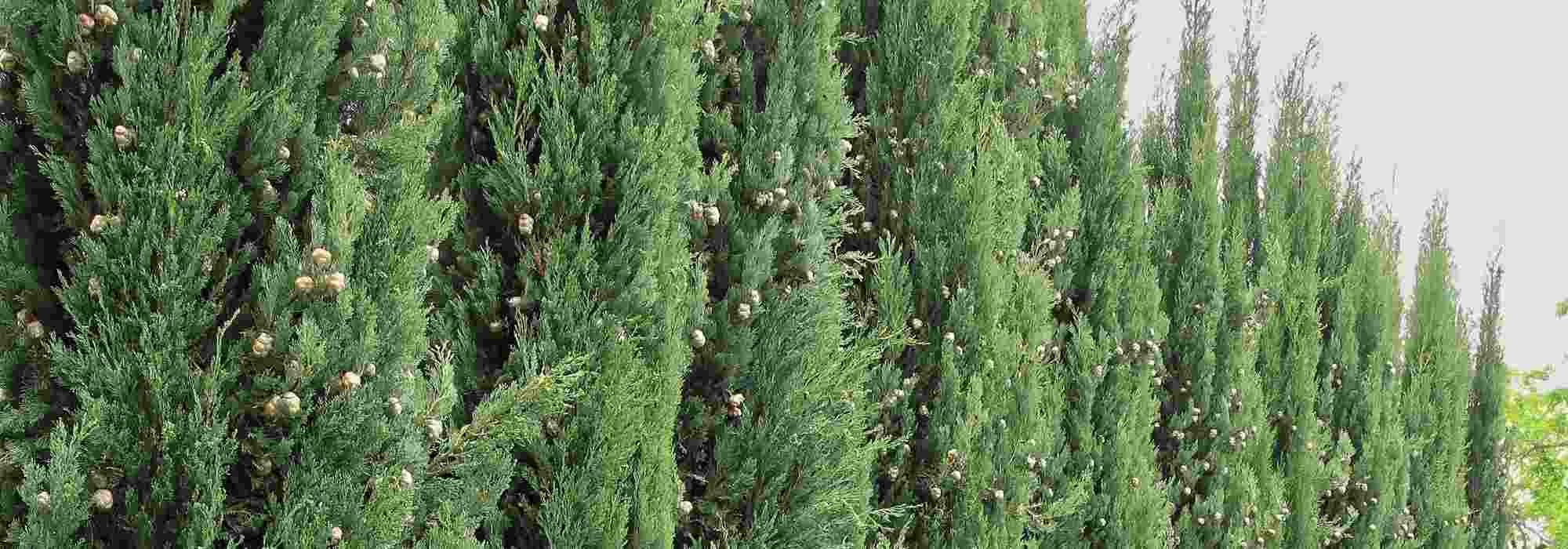
7 trees for a windbreak
Trees for wind protection
Summary
Sometimes you need to protect yourself and your garden from wind. The simplest and most effective solution in this case is a windbreak hedge made of hardy trees or bushes that are very wind‑resistant. Moreover, it is best to choose essential‑oil species that retain foliage in winter. They will therefore be useful throughout winter as well. We have already covered a short selection of bushes with evergreen or marcescent foliage in a previous advice sheet. Let’s now focus on larger specimens: trees. Discover our selection of trees that can be included in a windbreak hedge.
Quercus ilex or holm oak: acorns on evergreen foliage
Quercus ilex or holm oak, also known as Yeuse in Provence, is an evergreen forest tree quite emblematic of the southern Mediterranean. Remarkably robust, this tree also stands out for its natural, picturesque beauty.
Its growth is very slow; it will only grow 3 m in 20 years, reaching an adult height of about 15 m at maturity. However, it enjoys impressive longevity; specimens can easily reach a thousand years. You might say, “we’ll be long gone by then“, but it’s always moving, after planting a tree, to think that it will still be there several hundred years on.
Its bark, smooth ash-grey, cracks and flakes with the seasons, darkening to coal-black. Its leathery foliage, dark green above and silvery beneath, remains present throughout the year. The fruits are acorns; some are large and blunt while others are tiny and round like marbles.
With great hardiness and unassuming nature, the holm oak is indifferent to the mineral composition of the soil; it thrives in all types of well-drained soils. It is able to withstand drought and the most extreme temperature fluctuations, sharp cold and searing heat, provided it is exposed to full sun. But it also shrugs off wind, even strong gales.
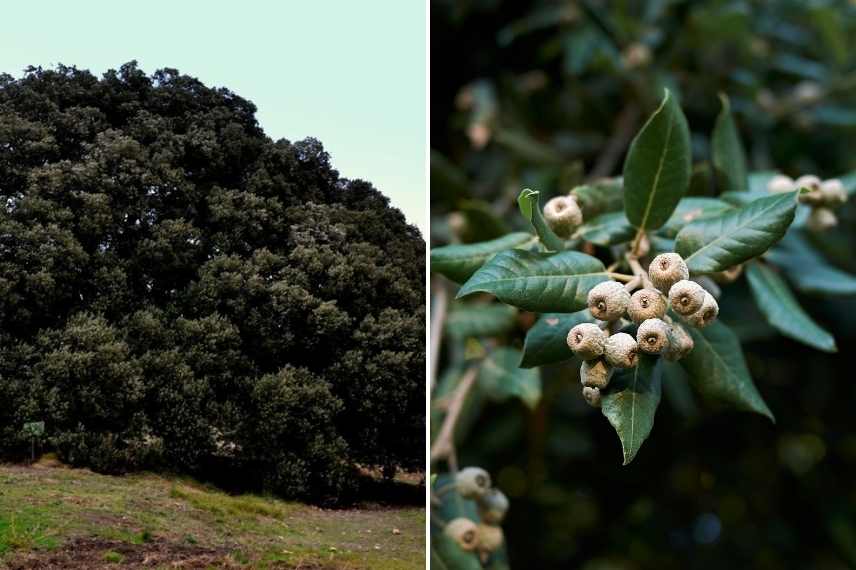
holm oak, foliage and fruits
→ Learn more about oak with our complete fact sheet
You may also read
How and why to create a windbreak hedge?Fagus sylvatica or common beech: neither evergreen nor deciduous
Beech or not beech, that is the question… Common beech, that of our forests, is neither evergreen nor deciduous: it has marcescent foliage, meaning dead leaves remain on twigs over winter. Like common hornbeam, which can also be planted in a windbreak hedge. Marcescence of foliage helps maintain an attractive screening appearance and allows your hedge to protect from wind even in winter.
Fagus sylvatica ‘Atropurpurea’, commonly called purple beech, is a handsome tree often used in hedging because it tolerates pruning very well. Purple beech is normally a sizeable tree with a semi-spreading habit and can reach up to 25 m tall at ripeness when grown singly.
Its marcescent foliage is very dense and made up of alternate leaves with undulate, villous edges. When young, leaves are a pretty pale green then take on a coppery purple colour. Fagus sylvatica ‘Atropurpurea’ also produces fruits, edible in small quantities, called beech-nuts, glossy brown and covered with bristly prickles.
Purple beech prefers partial shade and gentle sun. It prefers cool, temperate climates. Soil must be cool, well-drained and kept consistently moist as it copes poorly with drought.
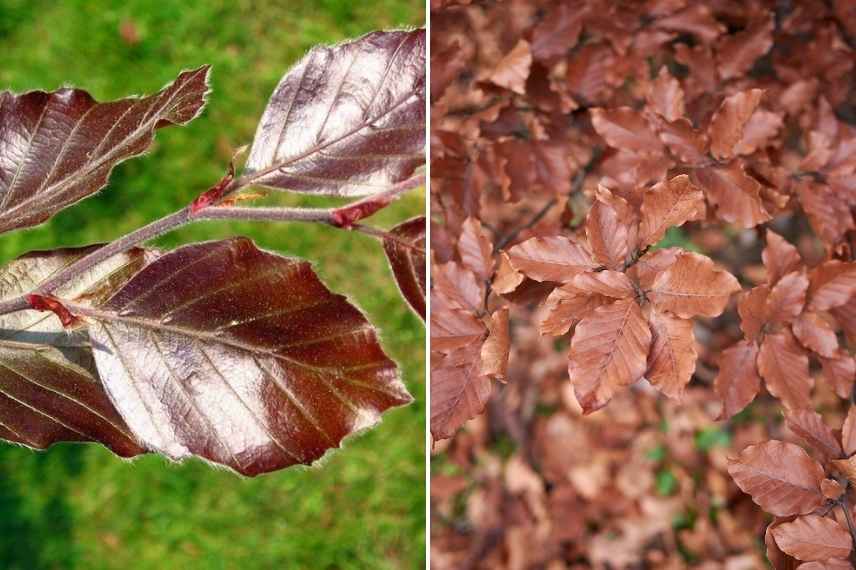
Fagus sylvatica ‘Atropurpurea’, very handsome marcescent foliage over winter
→ Learn more about beech with our complete fact sheet
Discover other Trees and large shrubs
View All →Available in 1 sizes
Available in 0 sizes
Available in 1 sizes
Available in 1 sizes
Available in 1 sizes
Available in 1 sizes
Available in 1 sizes
Available in 1 sizes
Available in 1 sizes
Available in 1 sizes
Populus nigra 'Italica' or Lombardy poplar: for areas around bodies of water
Populus nigra ‘Italica’ or Italian poplar is the quintessential avenue tree along banks of canals, rivers or shores of much of France and Belgium. This large tree is immediately recognisable by its very slender dark silhouette and habit almost columnar. It bears during the season a rustling, glossy dark-green foliage that turns a beautiful golden-yellow in autumn. With rapid growth, this robust poplar adapts to any soil that remains cool. Superb as a large windbreak curtain at the edge of countryside, it is also perfect near bodies of water.
This poplar develops a very spreading and extensive root system, and tends to produce suckers. It should therefore be planted at least 30 m from any building. Italian poplar can reach 30 m in height and 5 m in width, and its growth is rapid.
It develops a vertical trunk rising to top of the crown, without large secondary branch, but with multiple fine branches almost vertical, pressed against the trunk. Although its foliage is deciduous, the branches are so dense that they still provide screening even in winter.
Italian poplar, because of its vigorous development, should be reserved for large gardens. It is ideal, for example, along watercourses or close to ponds and large natural pools. But this tree, when planted densely, is also ideal for creating large windbreak screens.
Italian poplar is very hardy and thrives in any well-worked soil remaining fresh to moist with full sun exposure.
→ Also discover our full sheet dedicated to Poplars
You may also read
10 best bushes to create a windbreak hedgeIlex aquifolium or Common Holly: a large native
Common holly or Ilex aquifolium can become a genuine tree in a windbreak hedge if left to grow freely. This native species has many qualities: attractive evergreen foliage, astonishing ease of cultivation, excellent wind resistance and a contribution to biodiversity as it provides shelter and food for a variety of wildlife. Note that this holly is a dioecious species, which means male plants are distinct from female plants, which bear the characteristic red berries. If you want fruit on female plants, consider planting at least one male plant of the species in the garden (or nearby).
The variety Ilex aquifolium ‘Alaska’ is precisely a female specimen with an upright, compact habit. It is a large bush of more than 15 m at maturity (which is why it is included here) and grows in a columnar form but takes several years to reach full size. Like all common hollies, the ‘Alaska’ variety displays decorative evergreen foliage with ovate, undulate and very spiny leaves of glossy dark green colour.
During May and June, scented, melliferous, white, slightly pink flowers appear close to the leaves. These flowers will be followed, if a male plant is nearby, by small spherical bright red berries that are highly decorative.
Ilex aquifolium is very hardy (below -15°C). This type of large bush is ideal for a windbreak hedge because it tolerates both pruning and the strongest winds. Ilex aquifolium ‘Alaska’ prefers partial shade in a cool but well-drained, fairly fertile, and also humus-bearing soil.
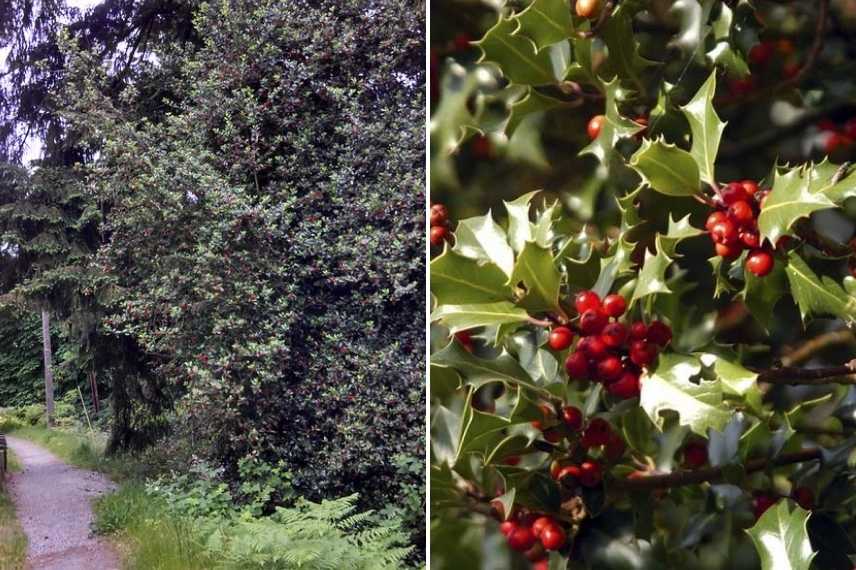
Ilex aquifolium, on the right foliage and berries of the Ilex aquifolium ‘Alaska’
Chamaecyparis lawsoniana or Lawson cypress: a giant for hedges
Chamaecyparis lawsoniana or Lawson cypress, sometimes called false cypress, is a majestic conifer that can reach over 40 m in height in its natural medium. It has given rise to many cultivars, among which there is a wide selection of plants of modest stature, better suited to scale of our gardens. It is often used as a hedge thanks to its tolerance of light, repeated pruning, its excellent screening ability and its excellent wind resistance.
Chamaecyparis lawsoniana ‘Alumii’ is a variety of Lawson false cypress much prized for its handsome dense pyramidal habit, flexible and regular, its branches with slightly trailing tips, and its elegant grey-blue foliage. This variety will not exceed 10–11 m in height with a 3 m spread.
Lawson false cypress ‘Alumii’ is grown in light soil that retains moisture, rich in humus, or sandy, slightly acidic, neutral or slightly calcareous. This conifer does well in sun in sufficiently humid climates, or in partial shade elsewhere. Lawson cypress suffers in soils and climates that are too dry as it is rather a tree of cool, oceanic or montane climate.
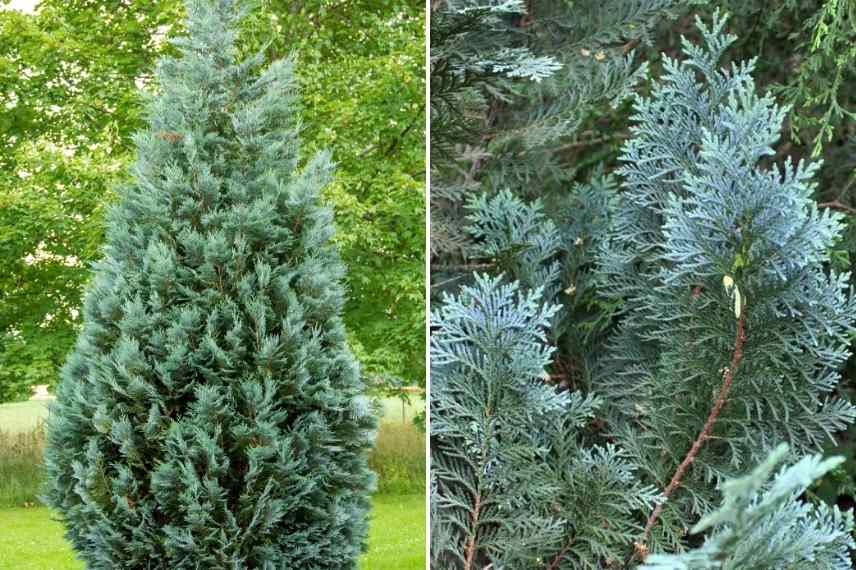
Chamaecyparis lawsoniana and foliage of Chamaecyparis lawsoniana ‘Alumii’ on the right
→ Find out more about Chamaecyparis or false cypress with our comprehensive factsheet
Cupressocyparis leylandii or (more simply) Leyland cypress: the classic
Cupressocyparis leylandii, better known as Leyland cypress or simply ‘Leyland’ is a classic that was perhaps overused in gardens of the 1970s and 1980s. But it must be admitted that as a large specimen for a windbreak hedge it is remarkably effective all year round.
Its growth is very fast. Leyland cypress can grow by one metre in a single year, reaching on average 20 m in height with a spread of 6 to 7 m if left unpruned (or when planted as a specimen). Because of this rapid growth, regular prunings (twice a year in May and September) will be necessary if you wish to keep it to 2 or 3 m in height. This conifer shows a naturally regular, pyramidal and dense habit. Its supple, slightly erect shoots are clothed in aromatic foliage that rustles a beautiful deep green.
Leyland cypress is perfect in a large, non-shared windbreak hedge, facing prevailing winds and preferably lightly pruned. This avoids the chore of pruning twice a year. ‘Leyland’ is ideal for very windy gardens, even in coastal locations. Moreover, its evergreen foliage provides permanent screening all year round while perfectly fulfilling its role as a privacy screen.
The root system of this tree is taprooted. This type of root allows it to anchor very deeply in the soil to draw water and nutrients, thus withstanding wind, even strong winds. Its hardiness is around -15/-20°C. ‘Leyland’ tolerates all soils, even poor, calcareous or clay soils. It resists pollution, sea spray and salty fogs.
Please note: This conifer produces pollen in early spring that may cause allergic reactions in some people.
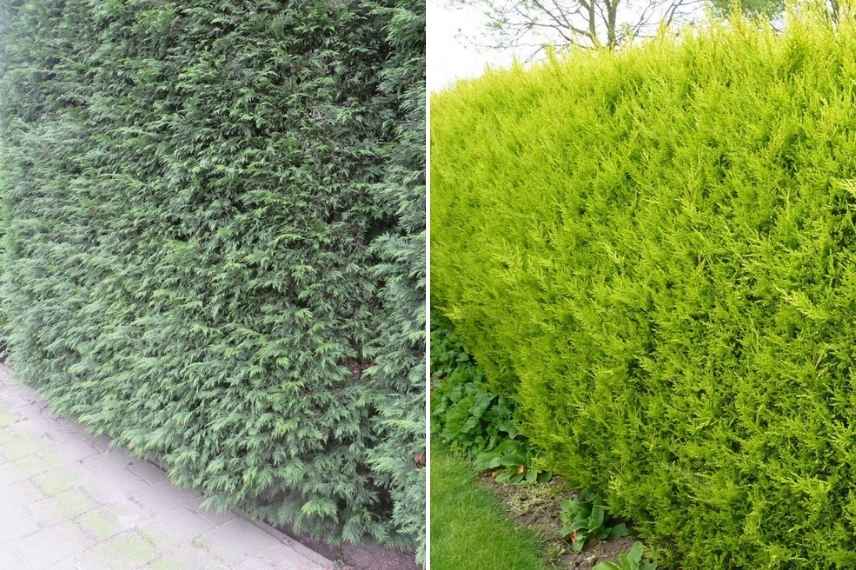
Leyland cypress, and Leyland cypress ‘Castelwellan Gold’
Cupressus sempervirens or Provence cypress: for the south
Cupressus sempervirens ‘Stricta’, more commonly Provence cypress is a spontaneous form of common cypress, selected for its narrow, upright habit. The ‘Stricta’ form is a natural mutation with erect shoots and produces fruit. This large evergreen conifer, clothed in dark green foliage, grows rapidly in its early years, and can live up to 500 years, eventually developing the characteristic silhouette that leaves its mark on Mediterranean landscapes.
Provence cypress ‘Stricta’ can reach 10 to 14 m in height with a spread of 2 m. Its growth is rapid and by age 6, in good conditions, it will already reach 6 m in height. It displays aromatic, dark foliage, and its wood is very fragrant like that of all common cypresses. Its root system is taprooted, allowing it to anchor very deeply in the soil to draw water and nutrients, and to withstand wind, even strong gusts. Its hardiness is good in well-drained soil, around -15°C. Unfortunately it should be confined to mild-climate regions because despite relative hardiness, it suffers mainly from excess water in winter, especially in heavy, clay soils.
Provence cypress ‘Stricta’ is perfect to flank an entrance, planted in groups of three specimens or for a slightly unusual windbreak hedge. A boon for gardens on causses with stony soil, where few trees thrive, its majestic habit structures a garden in a unique way, whether contemporary, Italian or Mediterranean in style.
Cupressus sempervirens thrives in a sunny position in well-drained soil, even poor, gravelly or rocky, because its taproot will always find a fissure and widen it to reach water. It is preferable to attempt cultivation only in areas with mild winters. The species Cupressus sempervirens‘ tolerance of limestone and strong winds (mistral and tramontane) makes this tree a classic of the Mediterranean landscape.
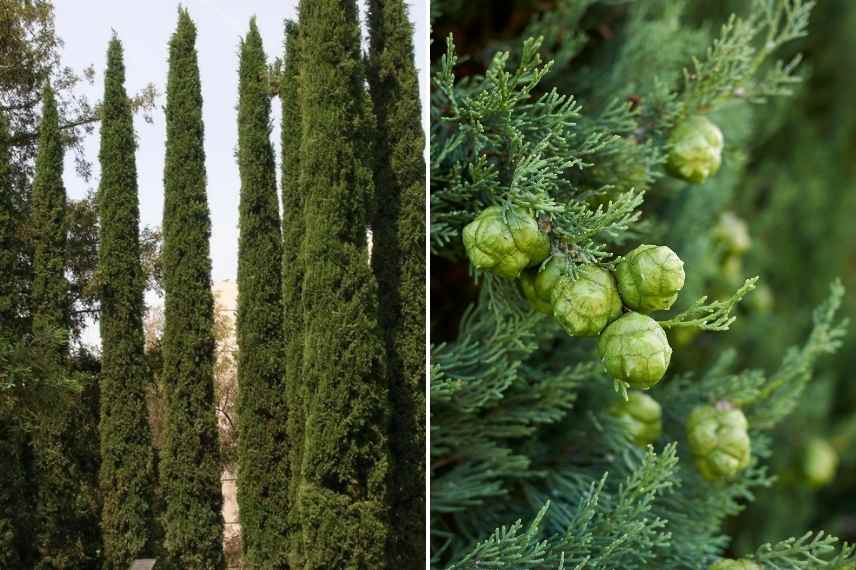
Cupressus sempervirens ”Stricta’, and foliage of Cupressus sempervirens
Further reading
Discover our other tips :
- How and why to create a windbreak hedge?
- Top 10 bushes for creating a windbreak hedge
- How to protect a garden exposed to strong winds
- Subscribe!
- Contents
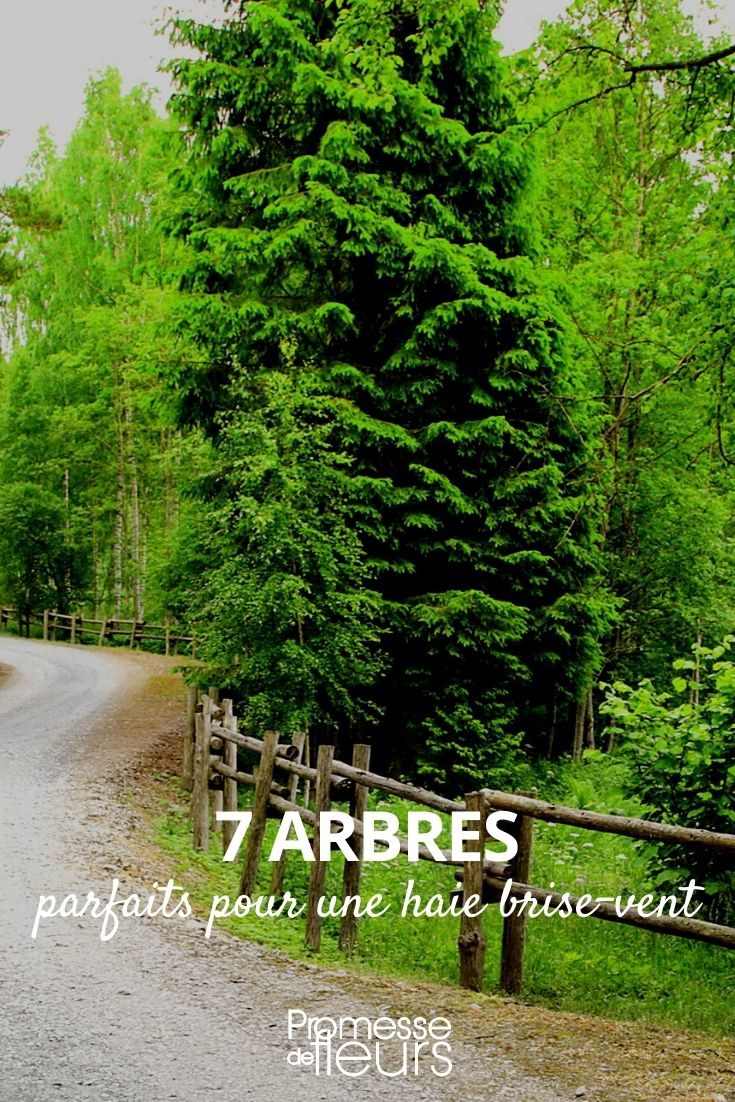

































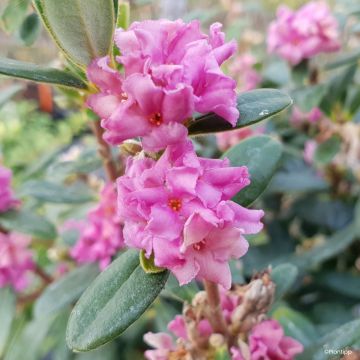
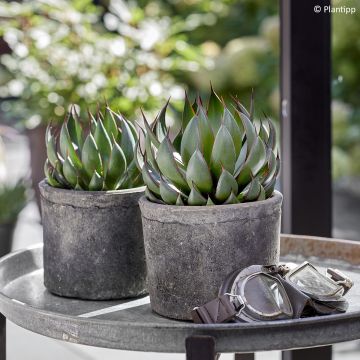
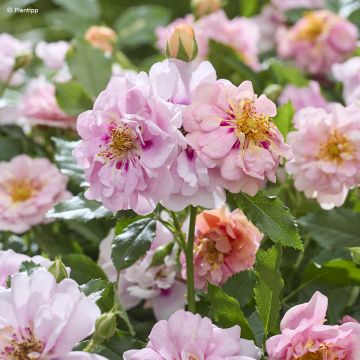
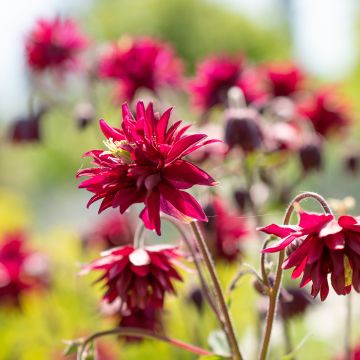
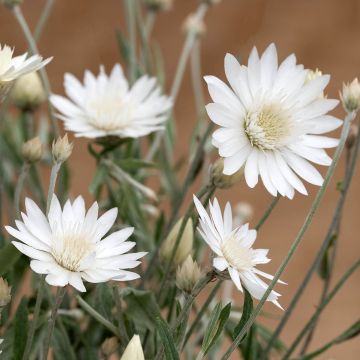
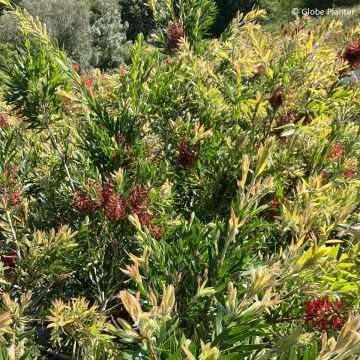
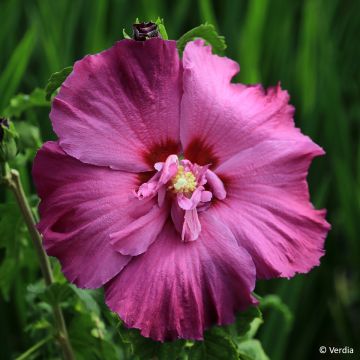
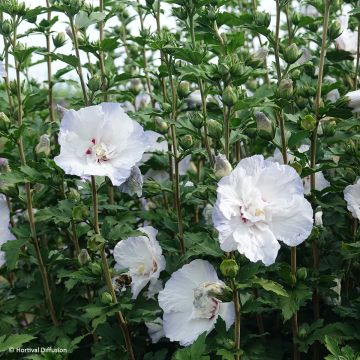
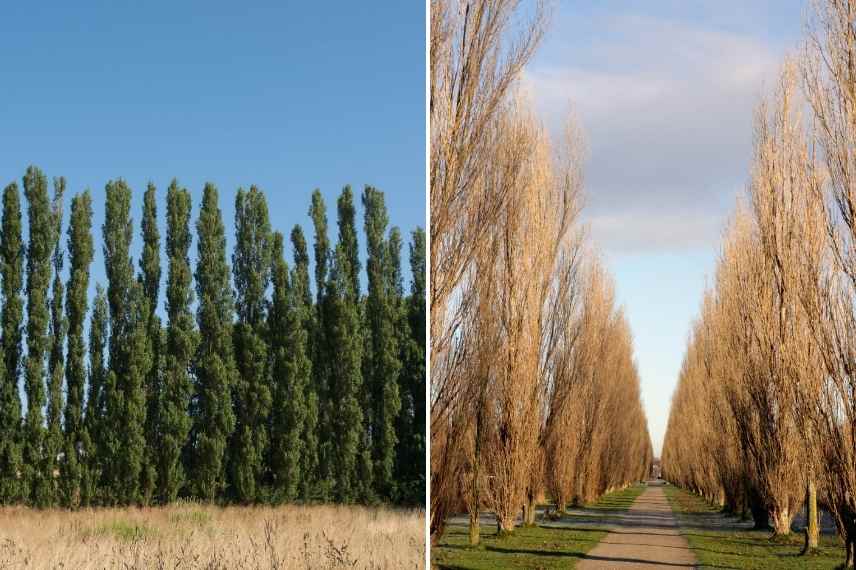
Feedbacks